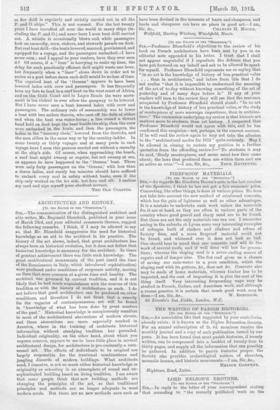ARCHITECTURE AND HISTORY.
[To THE EDITOR OF TEE " SPECTATOR." j
Sna—The communication of the distinguished architect and able writer, Mr. Reginald Blomfield, published. in your issue of March 23rd, and your editorial comments thereon, suggest the following remarks. I think, if I may be allowed to say so, that Mr. Blomfield exaggerates the need for historical knowledge as an aid to the architect in his practice. The history of the art shows, indeed, that great architecture hal, always been an historical evolution, but it does not follow that historical knowledge is necessary for the architect. In times of greatest achievement there was little such knowledge. The great architectural monuments of the past (until the time of the Renaissance in Italy, which introduced sophistication) were produced under conditions of corporate activity, moving on lines that were common at a given time and locality. The architect was governed by current tradition, and it is not likely that he had much acquaintance with the sources of this tradition or with the history of architecture as such. I do not believe that good. architecture can be produced on other conditions, and therefore I do not think that a remedy for the vagaries of contemporaneous art will be found in "knowledge of what has been done by great masters of the past." Historical knowledge is conspicuously manifest in most of the architectural aberrations of modern streets, and these aberrations are more especially marked in America, where in the training of architects historical information without steadying tradition has prevailed. Individual originality, on the other hand, about which you express concern, appears to me to have little place in normal architectural design, for architecture is pre-eminently a com- munal art. The efforts of individuals to be original are largely responsible for the irrational combinations and jangling discords of modern buildings. What architects need, I conceive, is not so much either historical knowledge or originality as schooling in an atmosphere of sound and un- sophisticated building based on living tradition. I am aware that some people think that new building methods are changing the principles of the art, so that traditional principles and methods are no longer adequate to meet modern needs. But there are no new methods save such as have been devised in the interests of haste and cheapness, and baste and cheapness can have no place in good art.—I am,






































 Previous page
Previous page